|
HOME: www.hiltonpond.org |
|||
|
All text & photos © Hilton Pond Center CONFUSING FALL . . .
COMPOSITES During late September at Hilton Pond Center the edges of our one-acre impoundment take on a yellow hue (above)--not just because tree leaves are changing but also from the appearance of hundreds of saffron-colored wildflowers that spring up in the shallows. Even from a distance we can tell from their configuration these two-inch blossoms are members of the Sunflower Family--the Asteraceae--whose scientific name denotes the flowers' star-like shape. (Asteraceae's former family name "Compositae" further indicates aster inflorescence is actually made up of two kinds of flowers, but we'll get to that below.) Yes, we know the yellow blooms are asters, but knowing exactly which kind caused us difficulty at first: In the Carolinas there are dozens--likely hundreds--of autumn sunflowers that make identification a bugaboo even for experienced botanists. Birdwatchers have their "Confusing Fall Warblers" of which there are only ten or so really difficult species, whereas wildflower enthusiasts are faced with the daunting task of identifying so many yellow autumn asters they sometimes throw up their hands in despair and simply call them DYCs--short for "damned yellow composites." So as not to offend the sensitivities of our readers, we'll follow the lead of ornithologists and refer to these sometimes-difficult-to-identify-flowers as CFCs--"Confusing Fall . . . Composites."
All text & photos © Hilton Pond Center Because many members of the Asteraceae look very much alike, identification to species level often depends on examining more than just the flower. Botanists may resort to looking at leaf shape, petiole and stem color, height of plant, shape of root, whether the green parts are fuzzy or smooth, and--of course--in which season the flower opens and the habitat where it grows. In many cases, it's also important to have the mature seed in hand for microscopic examination; this requires marking an aster plot during a bloom and revisiting on a later date to collect the fruit. To further complicate matters, DNA research has put aster taxonomy in a state of flux, with new analyses causing plant specialists to lump and split species and even to move them from one genus to another. With all this in mind we went out this week on our trusty road bicycle to explore back roads of York County and see how many CFCs we could find and identify. Cars go 'way too fast for roadside wildflower watching so it's a lot easier to spot obscure roadside blooms from the saddle of a bike. Herein we present a gallery of some of those species in the hope we've gotten the IDs right. (Please e-mail corrections and/or comments to INFO.) Before starting out on our CFC bike trek, we took a closer look at those yellow asters growing on muddy margin of Hilton Pond (see photo of individual flower head above). This blossom revealed something about asters (or sunflowers) that folks sometimes don't realize:
All text & photos © Hilton Pond Center After identifying this first CFC at Hilton Pond Center, we mounted our carbon-fiber Fuji bicycle and headed down the highway. To start, we should point out some composite flowers have no ray flowers and some have no disk flowers, but most have both. For example, all the Hawkweeds (Hieracium spp.)--such as the non-native one above we soon found growing close to the Center--have only ray flowers, as does the Common Dandelion that Hawkweeds resemble. We're pretty sure the flower in this photo is H. lachenalii, Common Hawkweed, but since there are more than 10,000 named species and subspecies we can't be 100% sure. Without disk flowers, most Hawkweeds resort to agamospermy--reproducing asexually through seeds derived from the ovary--which means the daughter plants that sprout are exact genetic copies of their mothers.
All text & photos © Hilton Pond Center A little further down the road we stopped our bike to look at another patch of CFCs. Although lots of "confusing fall composites" are predominately yellow, one can still find them in white and other colors, too. Annual Daisy Fleabane, Erigeron annuus (above), with 50 to 120 narrow ray flowers and a pale yellow center is one of the most common. In the Carolina Piedmont this species actually starts blooming in spring and continues through until late autumn, sprouting along highways and spoil places and but even popping up in well-tended lawns. Native bees and flower flies (Syrphidae) frequent fleabanes for nectar and insure that pollination occurs. This widespread North American native has been introduced to Europe, where it has become naturalized and sometimes invasive. Fleabanes are so-named because it once was thought dried clusters of the flowers and stems could eliminate biting fleas from bedding.
All text & photos © Hilton Pond Center A little further on we saw a second native species of white CFC. It turned out to be Frost Aster, Symphyotrichum pilosum (above), which grows in overgrazed pastures and other disturbed sites throughout the eastern third of North America from Hudson Bay to Texas and Florida, with a disjunct population in British Columbia. Stems of this plant are covered by dense fuzz, hence a species name that means "hairy" or "soft." Some sources say Frost Aster's common name also is derived from this fuzziness because it makes the aster appear covered by ice crystals; others claim "Frost Aster" denotes the species' ability to continue blooming--and nurturing pollinators--well past the first freeze of fall. Incidentally, in S. pilosum and many other CFCs the disk flowers turn pale red after pollination.
All text & photos © Hilton Pond Center As we pedaled further down our York County byway, we came to a flat stretch of moist road shoulder that supported a scattering of yellow-orange composites with dark centers. These--we determined after consulting several wildflower books--appeared to be Narrow-leaved Sunflowers, Helianthus angustifolius, AKA "Swamp Sunflower." The genus name indicates this is one of the "true sunflowers," with Helianthus derived from the Greek words helio ("sun") and anth ("flower"). Because this easily grown native species is widely cultivated for its ornamental showy inflorescence, it would be impossible to know whether plants we found were wild or garden escapes.
All text & photos © Hilton Pond Center When we bicycle in autumn in the Carolina Piedmont we often encounter large, five-foot-tall plants (above) with terminal clusters of white flowers. Invariably these turn out to be Tall Boneset, Eupatorium altissimum, sometimes called Tall Thoroughwort. This native CFC grows throughout the eastern half of the U.S. and most of Ontario in open, sunny, disturbed areas where it sometimes competes almost one-on-one with various tall Goldenrods, Solidago spp. Derivation of the common name "boneset" is unclear. Some authorities say it refers to use of the plant in treating broken bones; another source claims it was because an extract was used to treat intensely painful dengue fever, also called "breakbone fever."
All text & photos © Hilton Pond Center Tall Boneset is one of those attractive CFCs that looks even better in close-up view, especially when visited by the diurnal and incredibly colorful Ailanthus Webworm Moth, Atteva aurea. (Note the moth's extended proboscis probing boneset flowers for sweet nectar.) The photomacrograph also revels something else about Tall Boneset: The inflorescence contains ONLY disk flowers. Those spidery structures that appear to be twisted ray flowers are actually greatly extended stamens--the male part of the flower that produces pollen.
All text & photos © Hilton Pond Center And speaking of composites that have only disk florets, check out native Blue Mistflower, Conoclinium coelestinum, in the photo above. We found this colorful native wildflower thriving under a barbed wire fence along our cycling route. It's definitely neither a yellow or white aster but an incredibly intense bluish-purple one that stands out brilliantly in late September sun. Less confusing than most fall composites, Blue Mistflower can still be mistaken for the closely related but non-native Ageratum houstonianum, or Flossflower, an annual often grown by home gardeners.
All text & photos © Hilton Pond Center A close-up view of Blue Mistflower reveals its inflorescence does indeed consist only of disk flowers; as with Tall Boneset, what appear to be ray flowers are actually those long tongue-like stamens that emerge from the center of each individual disk flower. (Note especially the structure of three lowermost florets on the flower head at left.)
All text & photos © Hilton Pond Center Most of the fall composites we observed while cycling through western York County were yellow, and most had many ray flowers surround their central disk. One exception was the unidentified CFC above that had only five star-shaped ray flowers; although few in number, they were still showy enough to attract the attention of a tiny quarter-inch fly that came in for nectar.
All text & photos © Hilton Pond Center We also couldn't identify the bright yellow "confusing fall composite" in the photo above. Again, if you have a positive ID, please send it via e-mail to INFO.
All text & photos © Hilton Pond Center As we turned back toward home on a highway we don't usually cycle, we came across a big roadside colony of yellow composites that were striking not only for their density but also because a few plants were incredibly tall--at least 12' above the substrate. (In the photo above, compare the tallest plants at left with the relatively short 4-foot-tall Goldenrods at right.) The height immediately caught our attention because we knew from experience one of the few CFCs that towered that high was Schweinitz's Sunflower, Helianthus schweinitzii, a federally endangered species.
All text & photos © Hilton Pond Center After almost falling off our bike with excitement, we examined the flowers carefully for tell-tale signs: 1) Narrow lanceolate leaves with stiff hairs that made upper and lower surfaces feel rough; 2) Red stems and petioles; and, 3) 1.5 to 2" diameter flower heads with relatively short, wide ray flowers surrounding a dark central disk. Yes, it was for sure a thriving patch of Schweinitz's Sunflower--a relict plant that thrived thousands of years ago when this region of the Carolinas was covered not by oak-hickory forest but by a vast Piedmont Prairie. It wasn't quite as good as finding an Ivory-billed Woodpecker, but encountering this unknown stand of endangered asters was still pretty amazing.
All text & photos © Hilton Pond Center After basking for a long time in the glow of Schweinitz's Sunflowers, we cycled back to Hilton Pond Center for lunch, then headed off in another direction via motor vehicle to check on another small stand of Schweinitz's we had observed in previous years. Excited as we were over the robust colony we had seen that morning, we were gravely disappointed when we rounded a bend and discovered the other endangered sunflower plants were brown and withered (above), having fallen victim to some powerful non-selective herbicide. How sad that an isolated colony of this incredibly rare and endangered plant had been killed, albeit unwittingly, by a chemical apparently applied to keep pine trees from growing up into power lines. Surely a chain saw would have worked just as well at controlling the pines without bringing Schweinitz's Sunflower even closer to extinction. Alas, such roadside spraying (and mowing) are commonplace and may eventually eradicate this tall fall sunflower that we view as nothing short of spectacular.
All text & photos © Hilton Pond Center Saddened by the demise of these roadside Schweinitz's Sunflowers, we drove back to the Center and settled for finding more CFCs on our own protected property. All we could come up with was a pretty nice cluster of an unknown Solidago species (above), so we spent the rest of the afternoon looking at every single one of these Goldenrod plants and photographing tons of ray flowers and disk flowers and all the creatures that came to visit. But that's a story for another time, a future photo essay about just one genus among many "Confusing Fall . . . Composites" almost guaranteed to frustrate the botanist while delighting one's eye every autumn at Hilton Pond Center, and beyond. All text & photos © Hilton Pond Center |
 The Piedmont Naturalist, Volume 1 (1986)--long out-of-print--has been re-published by author Bill Hilton Jr. as an e-Book downloadable to read on your iPad, iPhone, Nook, Kindle, or desktop computer. Click on the image at left for information about ordering. All proceeds benefit education, research, and conservation work of Hilton Pond Center for Piedmont Natural History. The Piedmont Naturalist, Volume 1 (1986)--long out-of-print--has been re-published by author Bill Hilton Jr. as an e-Book downloadable to read on your iPad, iPhone, Nook, Kindle, or desktop computer. Click on the image at left for information about ordering. All proceeds benefit education, research, and conservation work of Hilton Pond Center for Piedmont Natural History. |
|
|
"This Week at Hilton Pond" is written and photographed by Bill Hilton Jr., executive director of Hilton Pond Center for Piedmont Natural History
|
|
|
If you Twitter, please refer
"This Week at Hilton Pond" to followers by clicking on this button: Tweet Follow us on Twitter: @hiltonpond |
Comments or questions about this week's installment? Send an E-mail to INFO. (Be sure to scroll down for a tally of birds banded/recaptured during the period, plus other nature notes.) |

Click on image at right for live Web cam of Hilton Pond,
plus daily weather summary
Transmission of weather data from Hilton Pond Center via WeatherSnoop for Mac.
|
--SEARCH OUR SITE-- For a free on-line subscription to "This Week at Hilton Pond," send us an |
|
Thanks to the following fine folks for recent gifts in support of Hilton Pond Center for Piedmont Natural History and/or Operation RubyThroat: The Hummingbird Project. Your tax-deductible contributions allow us to continue writing, photographing, and sharing "This Week at Hilton Pond." Please see Support if you'd like to make a gift of your own.
|
|
Make credit card donations
on-line via Network for Good: |
|
|
Use your PayPal account
to make direct donations: |
|
|
If you like shopping on-line please become a member of iGive, through which 800+ on-line stores from Amazon to Lands' End and even iTunes donate a percentage of your purchase price to support Hilton Pond Center .
 Every new member who registers with iGive and makes a purchase earns an ADDITIONAL $5 for the Center. You can even do Web searches through iGive and earn a penny per search--sometimes TWO--for the cause! Please enroll by going to the iGive Web site. It's a painless, important way for YOU to support our on-going work in conservation, education, and research. Add the iGive Toolbar to your browser and register Operation RubyThroat as your preferred charity to make it even easier to help Hilton Pond Center when you shop. Every new member who registers with iGive and makes a purchase earns an ADDITIONAL $5 for the Center. You can even do Web searches through iGive and earn a penny per search--sometimes TWO--for the cause! Please enroll by going to the iGive Web site. It's a painless, important way for YOU to support our on-going work in conservation, education, and research. Add the iGive Toolbar to your browser and register Operation RubyThroat as your preferred charity to make it even easier to help Hilton Pond Center when you shop. |
|



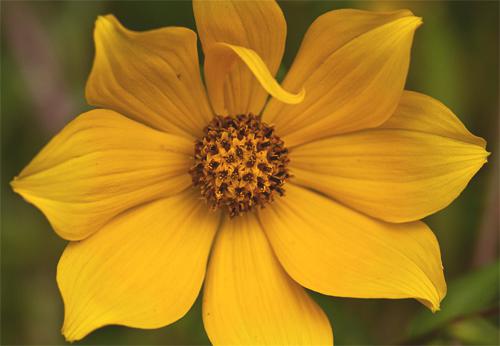
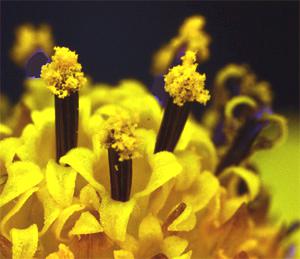 The reason they're also called "composites" is because the inflorescence is actually made up of two different kinds of flowers. Around the perimeter are lots of elongated, colorful structures that are incorrectly referred to as petals; these are actually "ray flowers" that are usually sterile but attract pollinators to the central "disk flowers" from which seeds are produced. A 3X macroscopic view of the disk flowers (above right) shows they--not the ray flowers--have true petals and bear stamens that yield pollen and stigmas that receive it. Based on ray flower shape, moist habitat, time of year, and stem and leaf configuration, we concluded the pond-edge CFC illustrated in the three photos above was Bidens polylepis, the Bearded Tickseed Sunflower.
The reason they're also called "composites" is because the inflorescence is actually made up of two different kinds of flowers. Around the perimeter are lots of elongated, colorful structures that are incorrectly referred to as petals; these are actually "ray flowers" that are usually sterile but attract pollinators to the central "disk flowers" from which seeds are produced. A 3X macroscopic view of the disk flowers (above right) shows they--not the ray flowers--have true petals and bear stamens that yield pollen and stigmas that receive it. Based on ray flower shape, moist habitat, time of year, and stem and leaf configuration, we concluded the pond-edge CFC illustrated in the three photos above was Bidens polylepis, the Bearded Tickseed Sunflower.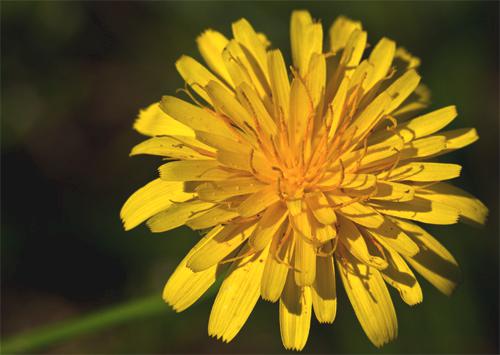

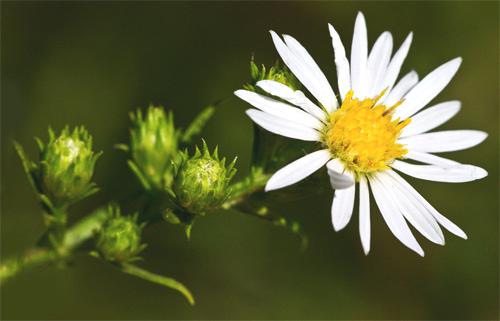
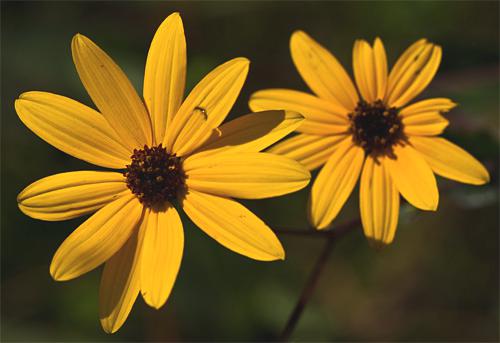
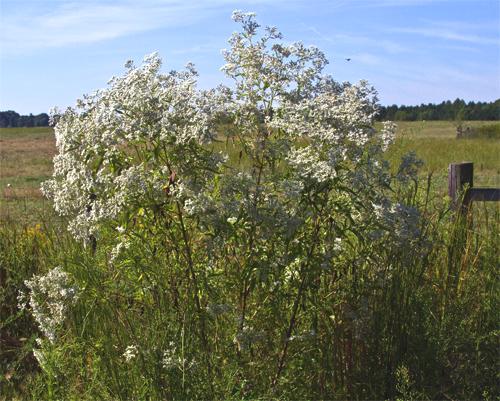
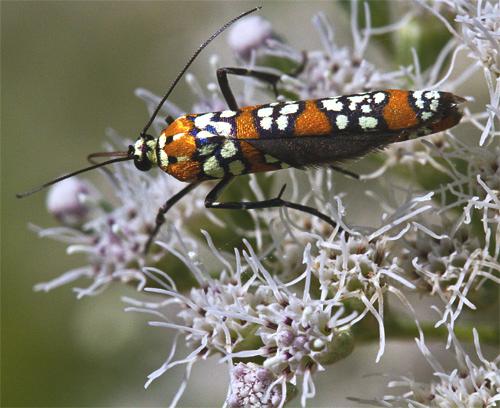

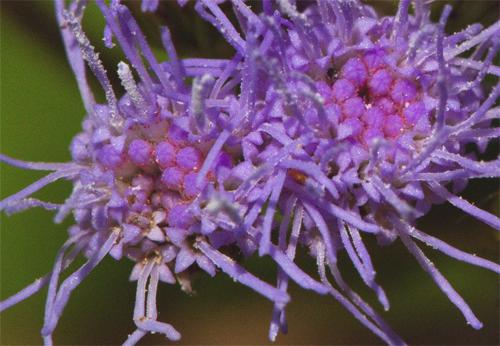
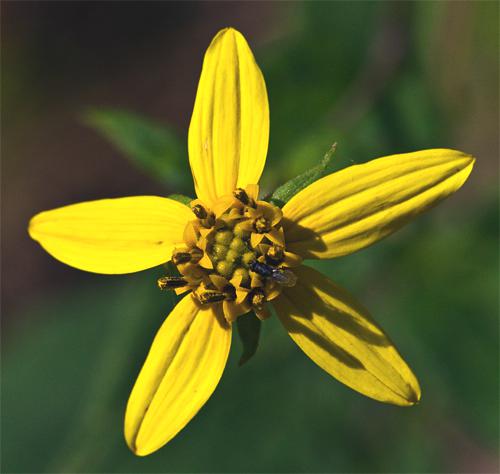
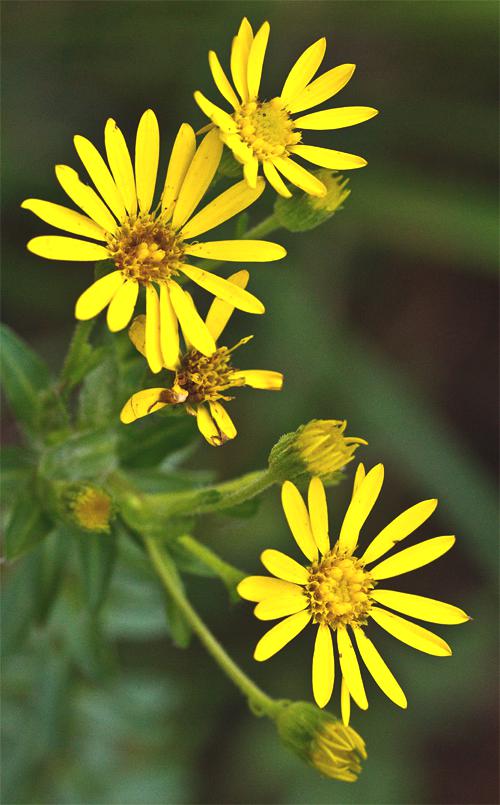
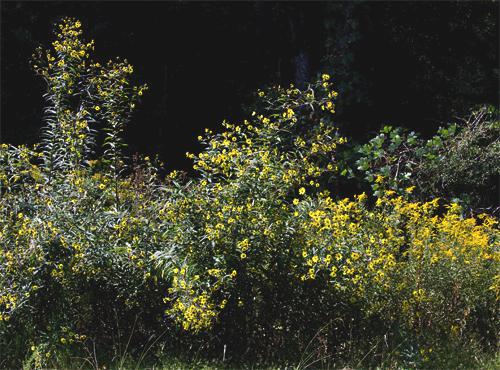
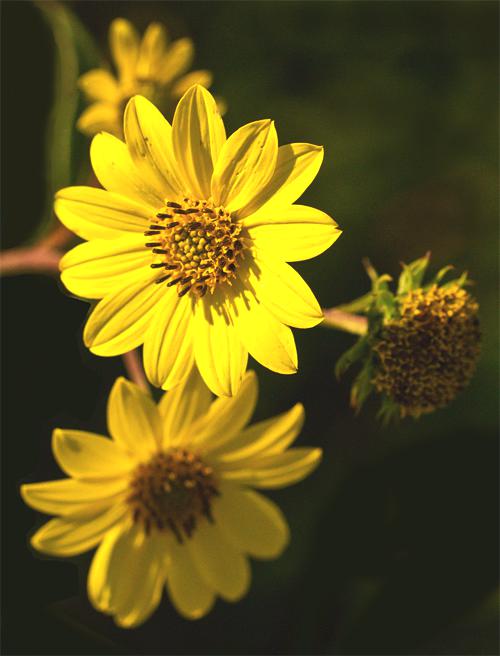
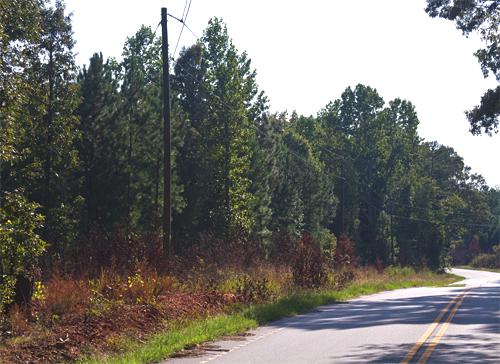
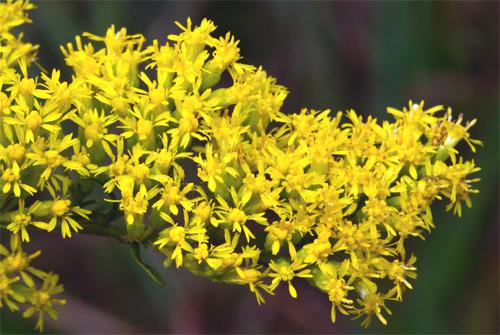


 Please report your
Please report your